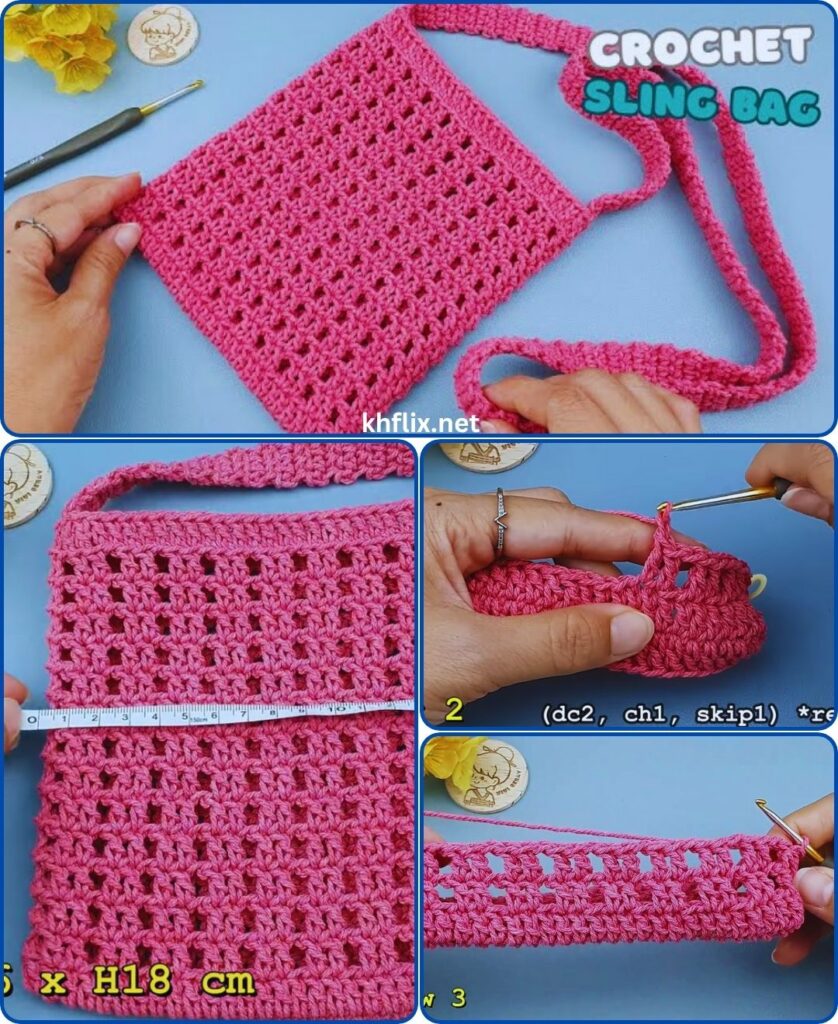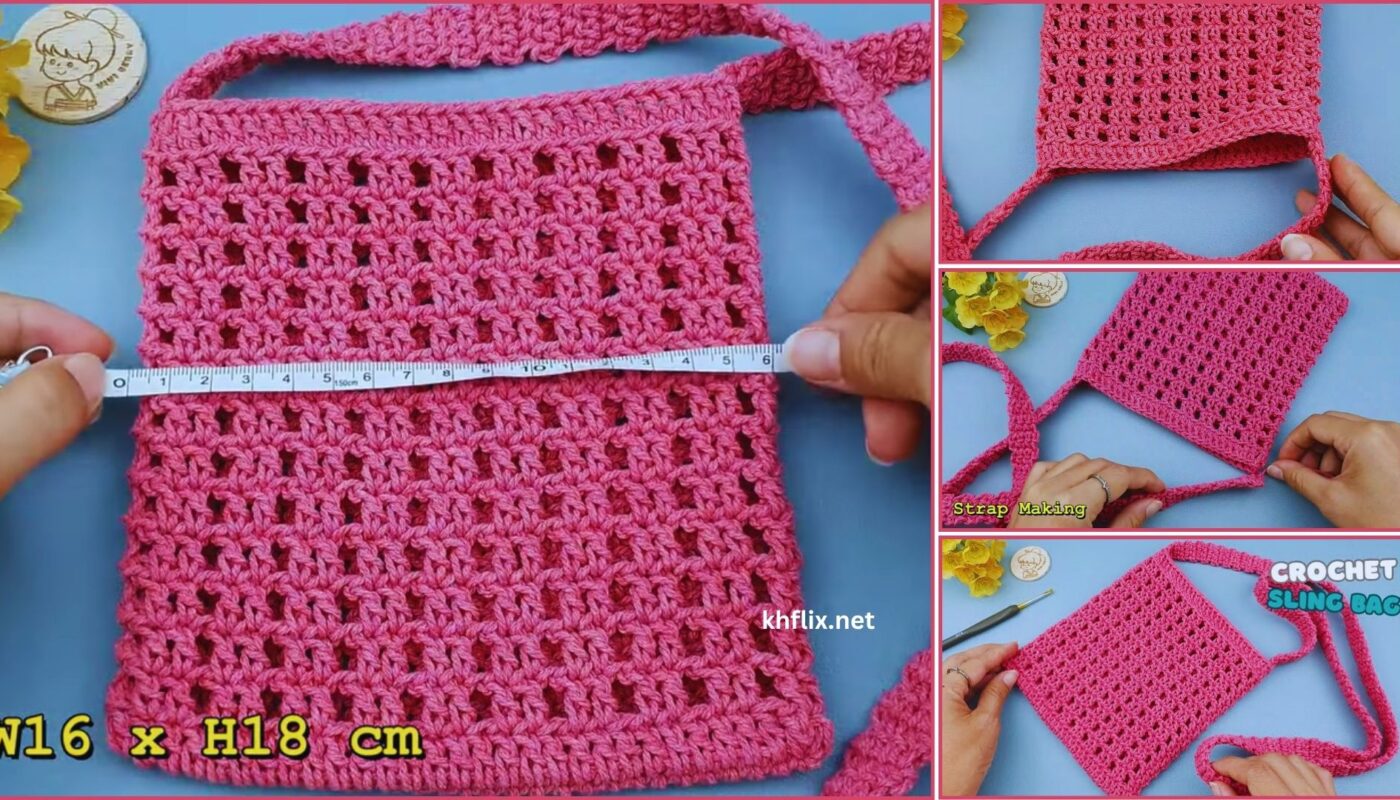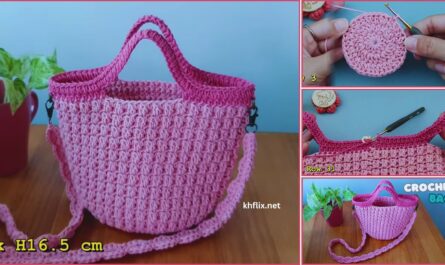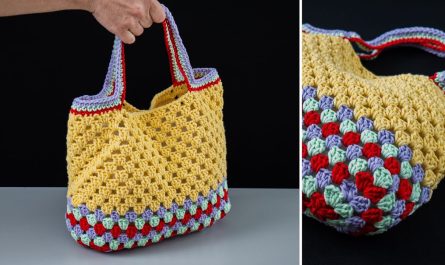Let’s create a stylish and practical crochet crossbody bag! A crossbody bag is incredibly versatile, keeping your essentials secure and your hands free. This detailed guide will take you step-by-step through the process, from creating a sturdy base to adding a comfortable strap and a functional closure.
How to Crochet a Crossbody Bag: A Detailed Step-by-Step Tutorial
This comprehensive tutorial will guide you in creating a durable and fashionable crossbody bag. We’ll focus on techniques that ensure a neat finish, a good shape, and the strength needed for everyday use.

Skill Level: Intermediate
This project assumes you’re comfortable with:
- Chain (ch): The basic foundation stitch.
- Slip Stitch (sl st): For joining rounds and neatening.
- Single Crochet (sc): A dense, sturdy stitch, ideal for bag bases and structure.
- Half Double Crochet (hdc): A slightly taller stitch that builds fabric quickly while maintaining good density.
- Working in rounds: Crocheting in a continuous or joined circular manner.
- Increasing: Adding stitches to expand your work (for the base).
- Working into specific loops (BLO/FLO): A simple but effective technique for creating defined edges.
- Weaving in ends securely.
- Basic hand sewing (for lining and hardware, if applicable).
Finished Bag Dimensions (Approximate):
This pattern creates a medium-sized crossbody bag, typically around 8-10 inches (20-25 cm) wide and 7-9 inches (18-23 cm) tall (excluding the flap and strap). You can easily adjust the size by modifying your starting chain and the number of rounds.
Materials You’ll Need:
- Yarn: Approximately 300-400 yards (275-365 meters) of Worsted Weight (Medium #4) Cotton or Cotton Blend Yarn.
- Why Cotton? Cotton yarn is highly recommended for bags due to its exceptional durability, minimal stretch (which helps the bag maintain its shape), and excellent stitch definition. It will help your crossbody bag withstand daily wear and tear.
- Color Choice: Choose a single beautiful color or a couple of complementary colors for your bag. A solid color will highlight the stitch texture, while two colors can create a subtle design if you alternate them (e.g., for the flap or strap).
- Crochet Hook: Size H/5.0mm or I/5.5mm. A 5.0mm hook generally creates a denser fabric, which is ideal for a sturdy bag. If your tension is very tight, you might prefer a 5.5mm.
- Yarn Needle (Tapestry Needle): Essential for seamlessly weaving in all your loose yarn tails.
- Scissors: For cutting your yarn.
- Stitch Marker (Optional but Highly Recommended): These are incredibly helpful for marking the beginning of your rounds, preventing you from losing your place.
- Magnetic Snap Closure (Recommended): A 0.5-0.75 inch (1.2-1.9 cm) magnetic snap provides a secure and professional closure.
- Fabric for Lining (Optional but Highly Recommended): A piece of cotton or poly-cotton fabric in a matching or complementary color, along with matching thread and a sewing machine or hand-sewing needle. A lining adds significant structure, prevents stretching, and ensures small items don’t slip through any stitch gaps.
Understanding the Bag Construction:
We’ll build this crossbody bag in a seamless, continuous manner for maximum durability and a clean finish. The process involves four main stages:
- Creating an Oval Base: This foundation gives your bag stability and shape.
- Building the Body: Working upwards in rounds to form the main structure of the bag.
- Crocheting the Flap: Adding a protective and decorative flap.
- Creating and Attaching the Strap: Making a comfortable and secure crossbody strap.
Let’s Crochet Your Crossbody Bag!
Part 1: Crocheting the Oval Base
A solid, flat base is crucial for your bag to sit properly and hold its contents without sagging. We’ll use single crochet (sc) for a dense and sturdy foundation.
- Starting Chain:
- Make a slip knot and place it on your hook.
- Chain (ch) 26. (This chain forms the initial length of your bag’s base. If you want a wider bag, chain more stitches; for a narrower one, chain fewer. Keep the number odd, as this typically results in an even number of stitches in your first working round.)
- Round 1:
- Work 2 single crochet (sc) stitches into the 2nd chain from your hook.
- Work 1 sc into each of the next 23 chains across.
- Work 3 sc into the very last chain. (This forms the smooth, curved end of your oval, turning your work around the corner.)
- Now, working down the opposite side of the foundation chain (into the bottom loops of the chains you just worked into): Work 1 sc into each of the next 23 chains across.
- Work 1 sc into the very first chain (the same chain where you placed the initial 2 sc).
- Slip stitch (sl st) into the first sc of the round to join.
- [Total: 52 sc] (This completes your first oval base round.)
- Round 2:
- Ch 1 (this chain does NOT count as a stitch, it just gives height).
- Work 2 sc into the first stitch (this is your first increase on the curve).
- Work 1 sc into the next 24 stitches.
- Work 2 sc into each of the next 3 stitches (these are increases evenly spaced around the curve).
- Work 1 sc into the next 24 stitches.
- Work 2 sc into each of the last 2 stitches (increases around the final curve to complete the oval shape).
- Sl st into the first sc to join.
- [Total: 58 sc]
- Round 3 (Optional for a slightly larger base):
- Ch 1.
- Work 2 sc into the first stitch.
- Work 1 sc into the next 26 stitches.
- Work 2 sc into each of the next 3 stitches.
- Work 1 sc into the next 26 stitches.
- Work 2 sc into each of the last 2 stitches.
- Sl st into the first sc to join.
- [Total: 64 sc]
- Important Base Check: At this point, your base should be a flat oval that lies nicely without curling up or ruffling excessively. If it curls, you might need to add one more round of increases following the established pattern. If it ruffles, you’ve likely increased too much in a previous round, and you may need to undo that round and adjust. The goal is a perfectly flat, stable foundation for your bag.

Part 2: Crocheting the Bag Body
Now we’ll transition from the flat base to build the upright sides of your crossbody bag. We’ll use half double crochet (hdc) for this section. Hdc creates a fabric that’s dense and sturdy, similar to single crochet, but it works up a bit faster, allowing your bag to grow efficiently.
- Round (Transition to Body – Creating the Defined Edge):
- Ch 1 (does NOT count as a stitch).
- Work 1 hdc in the back loop only (BLO) of each stitch around. (This is a crucial step for a neat finish! By working only into the back loop, you create a beautiful, defined ridge where the base seamlessly transitions into the bag’s upright sides. It gives your bag a professional, structured look.)
- Sl st into the first hdc to join.
- [Total: 64 hdc] (Your stitch count will remain exactly the same as your final base round, but the fabric will now start to turn upwards.)
- Round onwards (Building the Bag Sides):
- Ch 1 (does NOT count as a stitch).
- Work 1 hdc into each stitch around (now working through both loops as you normally would for hdc).
- Sl st into the first hdc to join.
- [Total: 64 hdc]
- Repeat this Round until your bag reaches the desired height. For a typical crossbody bag, aim for approximately 12-15 additional rounds of hdc from the BLO ridge, which should result in a bag about 7-9 inches (18-23 cm) tall. Adjust the number of rounds to make your bag taller or shorter as you prefer.
Part 3: Crocheting the Flap
The flap is a key feature of a crossbody bag, providing security and style. We’ll work this in rows, building directly off the back of the bag opening.
- Prepare for Flap:
- With your bag body complete, lay it flat. Identify the “back” side where you want your flap to attach. This will be the side opposite your working yarn if you’ve just fastened off, or you can just choose one.
- Count approximately 20-25 stitches across the top back edge of your bag (adjust this number to match the width you want for your flap – it should cover most of the opening). Mark the first and last stitch for your flap with stitch markers.
- Row 1 (Starting the Flap):
- Join yarn with a sl st to the first marked stitch.
- Ch 1 (does NOT count as a stitch).
- Work 1 sc in the same stitch and in each stitch across to your second stitch marker.
- [Total: 20-25 sc] (This count should match the number of stitches you decided for your flap width).
- Ch 1, turn.
- Row 2:
- Work 1 sc in each stitch across.
- Ch 1, turn.
- Continue Flap Body:
- Repeat Row 2 until your flap reaches the desired length. For a typical crossbody flap that covers the top opening and comes down a bit, aim for approximately 10-12 rows.
- [Total: 20-25 sc per row]
- Shaping the Flap (Optional – for a rounded or pointed flap):
- For a Rounded Flap:
- Next Row: Sc in first st, hdc in next, dc in next several stitches, hdc in last few, sc in last st.
- Next Row: Sl st evenly around the curved edge created, or work sc evenly around the edge to create a border.
- For a Pointed Flap:
- Decrease Row: Sc2tog, sc across to last 2 stitches, sc2tog. (Repeat this decrease row every 1-2 rows until the flap comes to a point or desired shape).
- For a Simple Straight Flap (As built above):
- Simply proceed to the border.
- For a Rounded Flap:
- Flap Border (Optional but Recommended):
- Ch 1. Work 1 sc evenly around the entire edge of the flap, working 2-3 sc into each corner to keep it flat. This creates a neat, finished edge.
- Sl st to join when you meet back at the bag body.
- Fasten off, leaving a tail for weaving in.

Part 4: Creating and Attaching the Strap
The crossbody strap is vital for comfort and functionality. We’ll make a sturdy, adjustable strap.
- Crocheting the Strap:
- With your yarn, Ch 8. (This will be the width of your strap. For a wider strap, chain more stitches; for a narrower one, chain fewer.)
- Work 1 sc into the 2nd chain from your hook and in each chain across. (You should now have 7 sc).
- Ch 1, turn (this is your turning chain for the next row).
- Work 1 sc into each of the 7 sc across.
- Repeat the last step (Ch 1, turn, sc across) until your strap reaches the desired length. For a typical crossbody strap, aim for approximately 45-55 inches (114-140 cm). This length allows it to sit comfortably across the body. You can always adjust this to your height and preference.
- Fasten off, leaving a very long tail (at least 12-18 inches / 30-45 cm) on each end of the strap for sewing.
- Attaching the Strap:
- Identify the two top side corners of your bag opening (where the flap is NOT attached).
- Thread one of the long tails of the strap onto your yarn needle.
- Firmly sew one end of the strap to the inside top corner of one side of the bag, going through multiple layers of stitches. Make several passes with your needle to ensure it’s very secure, forming an “X” or rectangle of stitches for strength.
- Repeat for the other end of the strap, attaching it to the top corner of the opposite side of the bag. Ensure the strap is not twisted before sewing.
Part 5: Finishing Touches (Highly Recommended for a Truly “Beautiful” Bag!)
These final steps are what will truly make your handmade bag look polished, professional, and built to last. Don’t skip them!
- Weave in ALL Ends: This is often the least favorite part of crocheting, but it’s absolutely critical for a clean, neat, and durable bag. Use your yarn needle to meticulously weave in all remaining tails (from your starting chain, any Fasten Off points, and strap sewing tails).
- How to Weave Neatly: Weave the tails into the stitches on the inside of the bag. Weave in one direction for about 1.5-2 inches (4-5 cm), then subtly change direction and weave back through some of the same stitches. This “locks” the tail in place and prevents it from unraveling. Be patient and thorough; well-woven ends are practically invisible and significantly contribute to your bag’s longevity and appearance.
- Blocking (Optional but Very Helpful): Blocking is a process that sets your stitches, evens out tension, and helps your bag take on its intended shape. It can make a huge difference in the final look.
- Gently stuff your bag with towels or crumpled paper to fill it to its desired shape. Ensure it’s plump and even.
- Using a spray bottle, lightly mist the entire bag evenly with water (if using cotton yarn). For some synthetic fibers, you can gently hover a steamer or an iron (on a low, steam setting) over the fabric without touching it.
- Gently shape the bag with your hands while it’s damp, ensuring the base is flat, the sides are even, and the flap lays nicely.
- Allow the bag to air dry completely and thoroughly before removing the stuffing. This can take 24-48 hours.
- Lining the Bag (Highly Recommended for Durability & Functionality): A fabric lining dramatically improves the functionality and longevity of any crochet bag. It provides significant structure, prevents the bag from stretching out, helps it hold its shape even when filled, and, crucially, ensures small items (like keys, pens, or coins) don’t slip through any tiny gaps in your crochet stitches.
- Measure: Carefully measure the finished dimensions of your crochet bag: its height, its width, and the length/width of its oval base. Also measure the flap.
- Cut Fabric: Cut fabric pieces to match the inside dimensions of your bag. You’ll typically need a main body piece (a large rectangle that will wrap around the inside) and a separate oval piece for the bottom, mirroring your crocheted base. You’ll also need a fabric piece for the inside of the flap. Remember to add a generous seam allowance (e.g., 1/2 inch or 1.2 cm) to all edges of your fabric pieces.
- Sew Fabric Lining: Stitch the fabric pieces together (right sides facing each other) to create a fabric “bag” that will fit snugly inside your crochet bag. Stitch and hem the flap lining piece separately. Press all seams open for a neat finish. Create a neat hem around the top edge of the bag lining.
- Insert and Secure: Carefully place the completed fabric bag lining inside your crochet bag. Align the top edges of both the crochet bag and the lining. Fold the hemmed top edge of the lining over the top edge of the crochet bag slightly (if needed) to create a clean finish. Then, using matching thread and a hand-sewing needle, hand-stitch the lining securely to the inside top edge of the crochet bag. Stitch the flap lining to the inside of the crochet flap. Stitch carefully so the stitches are not visible from the outside of your beautiful bag.
- Attach Magnetic Snap Closure:
- Decide where you want the closure. Usually, one part goes on the underside of the flap (about 1-2 inches up from the flap’s edge) and the other part on the front of the bag body, centered horizontally.
- Mark the spot carefully.
- Use your yarn needle and matching yarn/thread to sew the snap pieces securely to the crochet fabric (and lining, if applicable). For magnetic snaps with prongs, you’ll push the prongs through the fabric and bend them back, often with a metal washer to reinforce. If you have a lining, you might want to do this before fully stitching the lining down, or make small slits in the lining to push the prongs through and then cover them with a small piece of felt.
Congratulations! You’ve now created a truly beautiful, sturdy, and functional crochet crossbody bag that’s ready to carry your essentials in style. This handmade accessory is a wonderful testament to your creativity and skill! What exciting adventures will your new crossbody bag join you on?




